OnePlus One Review
The OnePlus One is one of the best Android phones available for its price.
Why you can trust Tom's Guide
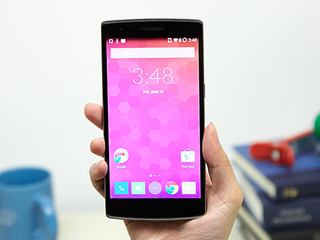
EDITORS' NOTE: This review was updated to reflect the new, lower price, as well as the phone's wider availability.
The OnePlus One is dubbed the "flagship killer" — and with tons of premium features for a shockingly low price of $249 unlocked, it just might be one. This plus-size phone packs a thin, sexy design; a sharp, full-HD display; and an impressive 13-MP camera, allowing you to enjoy all of the features you'd expect from the likes of Samsung and LG for a fraction of the cost.
Design
As soon as I picked up the OnePlus One, I was immediately impressed with how light and cozy it felt.

With sharp, 0.35-inch-thick edges and a gray, sandpaper-like texture on the rear panel, the One is remarkably easy to hold for a device bigger than 5 inches.

The One is as attractive as it is comfortable, sporting a stripe of silver along the edges and subtle curves along the top and bottom. My only design-related gripe is with the capacitive Back, Home and Recent Apps buttons right under the display, which are small and dim even when fully lit.
Measuring 6.0 x 2.9 x 0.35 inches, the OnePlus one is a little smaller than the iPhone 6 Plus, a little bigger than the G3 and almost identical in size to the Galaxy Note 4. The 5.7-ounce handset is lighter than the Note 4 and 6 Plus by less than an ounce, and just a smidgen heavier than the 5.3-ounce G3.
Display
Thanks to the One's crisp and colorful 5.5-inch, 1920 x 1080-pixel display, navigating the handset's vibrant home screen was just as enjoyable as watching HD movies. Speaking of movies, the trailer for Avengers: Age of Ultron looked rich, from minute details such as Nick Fury's eye scars to the reflective reds and golds of Iron Man's massive Hulkbuster suit.
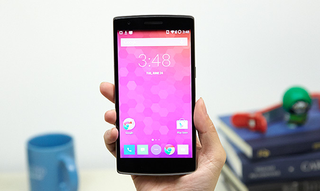
The OnePlus One's screen isn't just crisp; it's also one of the brighter ones we've tested, at 432 nits.
The One wasn't quite as impressive in terms of color representation and accuracy, however. The phone displayed 92.7 percent of the sRGB color gamut, which is close to the 6 Plus (95 percent) and G3 (93.4 percent) but nowhere near the Note 4's 163 percent. OnePlus' phablet has a Delta-E (color accuracy, lower numbers are better) of 8.6, which is far from a perfect 0 and less accurate than the Note 4 (4.2), the G3 (5.5) and the 6 Plus (1.9).
Audio
For a big phone, the OnePlus One's bottom-facing JBL speakers aren't exactly booming. The clean guitar portions of the Foo Fighters' "The Pretender" sounded crisp enough, but things started to get muddy once the distortion and vocals kicked in.
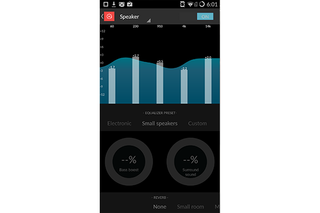
Despite its mixed audio quality, the One netted an above-average 86 decibels on our audio test, in which we measure a tone's volume from 13 inches away. OnePlus' handset rang louder than the Note 4 (81 decibels), the iPhone 6 Plus (78 decibels), the G3 (84 decibels) and the 81-decibel smartphone average.
MORE: Tom's Guide Best Gift Ideas
If you want to tinker with the One's sound output, the included Audio FX app packs preset profiles for genres such as Dance, Classical and Pop, as well as different reverb modes ranging from Small Room to Large Room. These Audio FX presets work with the built-in speakers, as well as any headphones or external speakers attached to the One.
CyanogenMod Interface and Lock Screen
If you think the One's default interface looks too glossy to be stock Android, it's because it's not. The phone layers Android 4.4.4 with the CyanogenMod Interface, which adds a slick, TouchWiz-esque coat of paint over its home screen and menus while offering some unique features of its own.
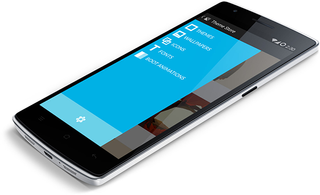
App icons and menus generally look flatter and more boxlike on CyanogenMod — an aesthetic that, ironically, brings Google's new Android Lollipop update to mind. If you're big on switching up your software's look, you'll like that CyanogenMod supports a variety of themes, from the spaced-out "Flux" look, to the more self-explanatory "Clean."

Other neat CyanogenMod touches include the ability to set different sound volumes for specific apps and functions, as well as the option to change what each capacitive key does when you long-press it. For example, long-pressing the home button brings up Google Now by default, but you can trigger it to do things such as open the camera or pull up recent apps.
One of the key things that sets CyanogenMod apart from stock Android is the software's unique array of lock-screen gestures. You can essentially sketch out whatever action you want to perform right out of the lock screen. Drawing a "V" activates the flashlight, making a circle opens the camera and creating two vertical lines triggers your music to pause. The gestures are fairly intuitive to use, and offer a fun and easy way to perform typical lock-screen actions.
CyanogenMod has been updated since the OnePlus One's summer launch, with the latest 11S 33R patch adding improved touch-screen responsiveness and support for RAW image files. The update also adds support for high-definition audio and ANT+ compatibility, the latter of which allows the One to be used with fitness trackers.
Security
CyanogenMod isn't just more customizable than stock Android; it's also slightly more secure. Texts between CyanogenMod users are automatically encrypted, though that feature's usefulness depends on how many of your friends also use the software.

The phone's Privacy Guard feature gives you lots of control over how each of your apps can access your data, with specific switches for things like location, messages, personal information and media. You can also glance at how many times each app has dipped into each type of personal data.
MORE: Smartphone Interactive Buying Guide
If you're interested in the nuts and bolts, the One utilizes the SELinux (Security-Enhanced Linux) security module, which powers the type of fine-tuned process control that the phone offers.
Apps
The OnePlus One comes loaded with a few neat CyanogenMod apps that complement stock Android fare such as Chrome and Hangouts. Screencast makes it easy to record whatever's happening on the display, while Torch is a fancy name for activating the handset's rear-facing flashlight.

CyanogenMod puts its own spin on standard apps such as Camera, Messaging and Gallery. For example, the Gallery lets you view your photos in clusters based on date and location (similar to on iOS 8), and File Manager allows you to lock away your phone's storage so no one else can save files to it.
Performance
Packing a 2.5-GHz quad-core Snapdragon 801 processor, the OnePlus One can bounce between streaming video, Web pages and games without a hint of slowdown. Graphically rich games such as Asphalt: Overdrive ran smoothly and offered plenty of detail in my red Ferrari's paint job, while even more demanding titles, like N.O.V.A 3, loaded in a relatively brisk 15 seconds.
The One scored 2,504 on the Geekbench 3 performance test, falling behind the Note 4 (3,124) and the 6 Plus (2,903) while edging out the LG G3 (2,401) and the 2,183 smartphone average.
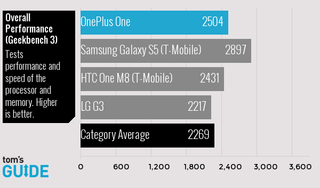
OnePlus' phablet took a fairly fast 5 minutes and 58 seconds to transcode a 204MB 1080p video clip down to 480p. While this is a bit slower than the Note 4's 5:15, the One outperformed the G3's 6:10 as well as the 7-minute smartphone average.
The One's graphics performance was just as impressive in benchmarks as it was in everyday use; the phone netted a 18,399 on the 3DMark Ice Storm Unlimited test, beating the LG G3 (15,395), the 14,520 smartphone average and the 6 Plus (16,965) while slightly trailing the Note 4's beefy 20,126.
Camera
Packing a 13-megapixel Sony rear camera, the OnePlus One is an ideal smartphone for mobile photo nuts. Outdoor shots taken in Manhattan's Flatiron District were detailed and colorful, allowing me to easily make out distant store logos and car license plates.

The phone's camera did a solid job of capturing my co-worker's facial and clothing details under low light, though there was some noticeable graininess when I kept the flash off. With the flash on, skin tones looked more natural, and clothing packed more detail.

The One shoots video in 1080p and, unlike some of its competitors, in ultra-high-def 4K. My videos of busy Sixth Avenue looked impressively vivid at both resolutions, though you'll need a 4K display to really appreciate any content you capture in Ultra HD. The phone's 4K videos are shot at 24 fps using 4K UHD mode (which most 4K televisions use), and at 30 fps with 4K DCI mode, which is more common in film.
The OnePlus One's camera app goes beyond what stock Android offers you, providing control over shutter speed, light metering mode and antibanding, the latter of which prevents the lines that pop up when you're photographing a TV or computer monitor.
The selfies I took with the phone's 5-MP front camera were similarly impressive. I was able to easily make out the tiny stubs of my five-o'clock shadow, as well as the fine textured stripes of my white sweater.
Battery Life
Running out of juice is the last thing you'll be worrying about when using the OnePlus One.

The handset endured a colossal 13 hours and 16 minutes on our battery test (Web surfing over AT&T 4G at 150 nits), crushing already long-lasting phones such as the 6 Plus (10:00) and Note 4 (8:43) and beating the 8:30 smartphone average.
Bottom Line
The OnePlus One is a gorgeous, powerful flagship phone that sells for a budget price. The handset’s rich HD screen, sharp camera and stunning battery life all hold their own against popular phones such as the Galaxy Note 4 and iPhone 6 Plus, and the inclusion of CyanogenMod provides a more attractive and robust experience than stock Android.
- How To Take Better Photos with Your iPhone
- 12 Surprising Things Your Android Phone Can Do
- 5 Ways to Free Up Storage on Your iPhone
Mike Andronico is an Associate Editor at Tom's Guide. When he's not writing about games, PCs and iOS, you can usually catch him playing Street Fighter. Follow Mike @MikeAndronico. Follow us @TomsGuide, on Facebook and on Google+
Sign up to get the BEST of Tom’s Guide direct to your inbox.
Upgrade your life with a daily dose of the biggest tech news, lifestyle hacks and our curated analysis. Be the first to know about cutting-edge gadgets and the hottest deals.
Mike Andronico is Senior Writer at CNNUnderscored. He was formerly Managing Editor at Tom's Guide, where he wrote extensively on gaming, as well as running the show on the news front. When not at work, you can usually catch him playing Street Fighter, devouring Twitch streams and trying to convince people that Hawkeye is the best Avenger.

